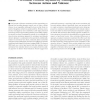Free Online Productivity Tools
i2Speak
i2Symbol
i2OCR
iTex2Img
iWeb2Print
iWeb2Shot
i2Type
iPdf2Split
iPdf2Merge
i2Bopomofo
i2Arabic
i2Style
i2Image
i2PDF
iLatex2Rtf
Sci2ools
JOCN
2010
2010
Approaching the Bad and Avoiding the Good: Lateral Prefrontal Cortical Asymmetry Distinguishes between Action and Valence
■ Goal pursuit in humans sometimes involves approaching unpleasant and avoiding pleasant stimuli, such as when a dieter chooses to eat vegetables (although he does not like them) instead of doughnuts (which he greatly prefers). Previous neuroscience investigations have established a left–right prefrontal asymmetry between approaching pleasant and avoiding unpleasant stimuli, but these investigations typically do not untangle the roles of action motivation (approach vs. avoidance) and stimulus valence (pleasant vs. unpleasant) in this asymmetry. Additionally, studies on asymmetry have been conducted almost exclusively using electroencephalography and have been difficult to replicate using functional magnetic resonance imaging (fMRI). The present fMRI study uses a novel goal pursuit task that separates action motivation from stimulus valence and a region-of-interest analysis approach to address these limitations. Results suggest that prefrontal asymmetry is associated with action mo...
| Added | 28 Jan 2011 |
| Updated | 28 Jan 2011 |
| Type | Journal |
| Year | 2010 |
| Where | JOCN |
| Authors | Elliot T. Berkman, Matthew D. Lieberman |
Comments (0)

